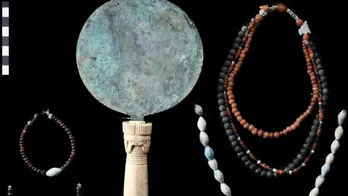Meet the American who 'won the war for us': Andrew Jackson Higgins, World War II New Orleans boatbuilder
Andrew Jackson Higgins was born and raised 1,000 miles from the ocean — yet he forever changed war fought from the sea.
He designed and manufactured the iconic World War II amphibious landing craft that delivered Allied troops onto hostile beachheads from North Africa to Iwo Jima and countless battle zones in between.
His "Higgins boats" became an icon of American and military ingenuity 80 years ago this week when they proved essential to the success of the epic D-Day invasion of Normandy on June 6, 1944.
ANNE FRANK'S SPIRITS SOARED ON D-DAY: ‘FRIENDS ARE ON THE WAY,' SHE WROTE OF HEROIC GIS
Higgins "is the man who won the war for us," Dwight D. Eisenhower said in a 1964 interview with historian Stephen Ambrose.
That was astonishing praise from the highest authority. Before becoming president, Ike was the supreme commander of the Allied Expeditionary Force in Europe. He planned and executed the D-Day invasion — the largest, most ambitious, most successful amphibious attack in the history of warfare.

Andrew Higgins while celebrating his company's production of its 10,000th boat in July 1944. His company produced the famous amphibious landing craft, dubbed Higgins Boats, that allowed Allied troops to insert with force into hostile territory around the globe during World War II. (National World War II Museum)
The Allies landed 160,000 men on the shores of France in the first 24 hours alone – many of them, if not most of them, sent into the breach from one of Higgins’ innovative steel-and-wood landing craft.
Higgins was a pugnacious Irish-American boatbuilder. Born in Nebraska, he rose to fame as a titan of wartime industry in New Orleans.
"Higgins is the man who won the war for us."
"With his wavy brown hair, square jaw and broad shoulders, Higgins looked like he could take care of himself in a fight," Paul Martin wrote in the 2012 book, "Secret Heroes: Everyday Americans Who Shaped Our World."
Commonly called Higgins Boats, his landing craft were officially known in military parlance as LCVPs (land craft, vehicle, personnel).
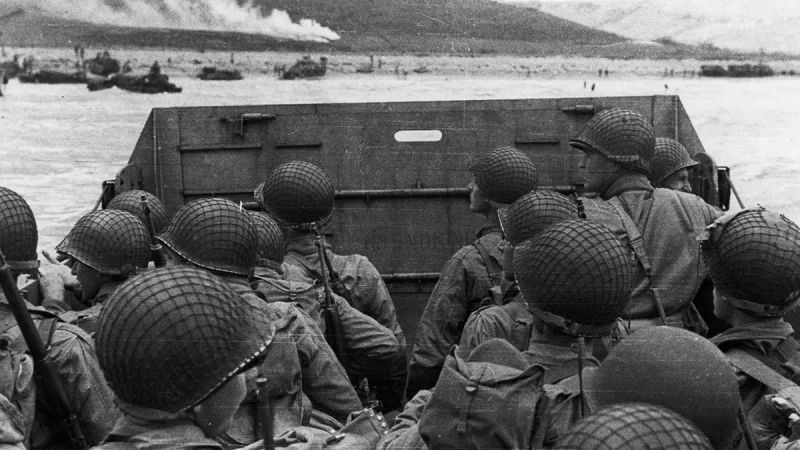
American assault troops in a landing craft near a beachhead in northern France. The landing was supported by naval gunfire. (MPI/Getty Images)
They were built to quickly unload men and equipment in shallow surf hazarded by underwater obstacles, then quickly reverse and return to the mother ship for more.
He developed a larger version of the Higgins Boat called LCMs (landing craft, mechanized), sturdy enough to deliver troops with a battle tank from ship to shore.
D-DAY BATTLE SITES EVERY AMERICAN SHOULD SEE AS EPIC INVASION FASCINATION DRAWS MILLIONS TO NORMANDY
The Army soldiers who fought their way up the spine of Italy to take it back from the fascists, the Rangers who scaled the cliffs of Pointe du Hoc on D-Day and the Marines who famously raised the flag over Iwo Jima all arrived into battle aboard Higgins Boats.
Gen. Douglas MacArthur famously splashed out of a Higgins Boat onto the Philippines in 1944.
"I have returned," MacArthur declared, two years after his forces in the Philippines were embarrassingly routed, his men killed, imprisoned and tortured by Japan.

In one of the most iconic images of World War II, Gen. Douglas MacArthur (left) and his chief of staff, Lt. Gen. Richard Sutherland (center) step off a Higgins Boat landing craft and wade through knee-deep water in October 1944, to reach Philippine soil for the first time since MacArthur was ordered from the Philippines to Australia in March 1942. (Getty Images)
The grim but effective utility of the Higgins Boat was popularized among a new generation of Americans in the horrific opening scene of the 1998 Tom Hanks war epic, "Saving Private Ryan."
"If it wasn’t for Andrew Higgins, the world could have gone a whole different way."
"If it wasn’t for Andrew Higgins, the world could have gone a whole different way," said Fred Hoppe, a Nebraska artist who shares the same hometown as the boatbuilder.
"It could have been tyranny for the world instead of victory for us."
Hoppe is celebrated for his sculptures that pay homage to American war heroes around the world, including two dedicated to Higgins: one in Nebraska and one at Utah Beach in Normandy.
MEET THE AMERICAN WHO EARNED THE MEDAL OF HONOR AND WAS MIA IN KOREA FOR 73 YEARS, CPL. LUTHER HERSCHEL STORY
The tributes are personal to Hoppe. His father, Fritz, landed in Anzio, Italy, aboard a Higgins Boat in 1944. He returned to raise a family but suffered from battle wounds the rest of his life.
Raised on the banks of the Big Muddy
Andrew Jackson Higgins was born on Aug. 28, 1886, in Columbus, Nebraska to John G. and Annie (O’Conor) Higgins.
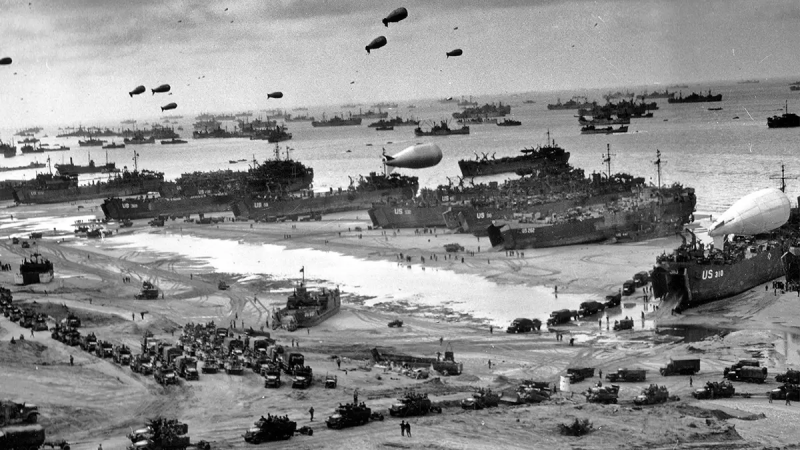
Photograph of D-Day landing craft, boats and seagoing vessels used to convey a landing force (infantry and vehicles) from the sea to the shore during an amphibious assault. Dated 1944. (Photo 12/Universal Images Group via Getty Images)
His dad, originally from Chicago, was a prominent judge, lawyer and newspaper publisher, connected at the highest levels of American politics.
"Higgins was a close friend of Grover Cleveland and an enthusiastic Democrat," Jerry Strahan wrote in his 1998 biography of the boatmaker, "Andrew Jackson Higgins and the Boats that Won World War II."
Strahan added, "So enthusiastic that he named his new son after the party’s twice successful presidential candidate Andrew Jackson."
MEET THE AMERICAN WHO LED 77 MINUTEMEN AGAINST 700 REDCOATS AT BATTLE OF LEXINGTON: CAPTAIN JOHN PARKER
John Higgins died after falling down a flight of stairs when Andrew was just 7 years old.
Annie Higgins moved the fatherless family to Omaha to begin life anew on the banks of the Missouri River.
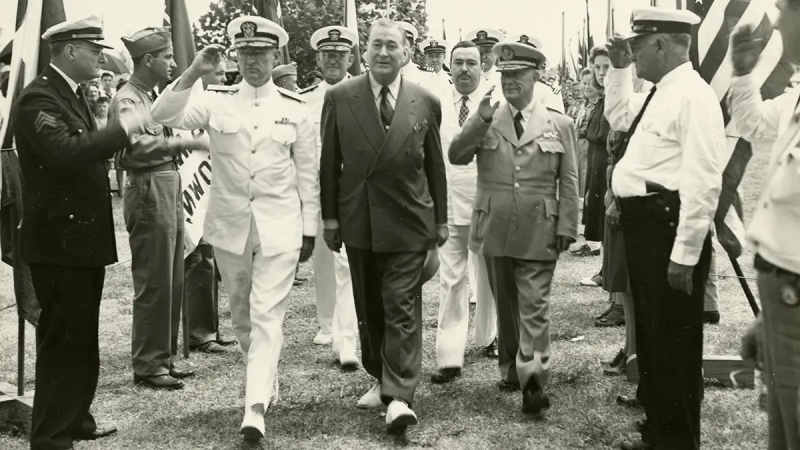
Andrew Higgins is flanked by two Naval officers saluting in New Orleans, Louisiana, July 23, 1944. Higgins was attending a ceremony honoring the completion of the U.S. Navy's 10,000th Higgins Boat at Lake Ponchatrain. (Rutherford Gares via The National WWII Museum)
It's apparently a quirk of history that the man who built the boats that achieved their greatest fame for attacking Omaha Beach in France on D-Day in 1944 spent his youth in Omaha, Nebraska.
The Missouri River proved the gateway to the deepest interior of the continent during the Lewis & Clark Expeditions. It was here along the shallow "Big Muddy" that Higgins drew the inspiration that would one day deliver American might across the deepest oceans.
Higgins joined the state militia where, among other things, he got his first taste of amphibious warfare.
Higgins joined the state militia where, among other things, he got his first taste of amphibious warfare.
"The troops had to cross the Platte River by pontoon," writes Strahan.
"The experience, coupled with a strong desire to read instilled in him by his mother, led Higgins to become a student of military history."
MEET THE AMERICAN WHO FIRST COMMANDED THE MARINES: REVOLUTIONARY WAR HERO SAMUEL NICHOLAS
But "money was scarce and times were hard," reports the website of the Andrew Jackson Higgins National Memorial in Nebraska.
Higgins sought opportunity elsewhere.
He moved to Mobile, Alabama, in 1906 and found employment in the lumber industry. He opened his own business, Higgins Lumber and Export Co., in New Orleans n 1922.

June 6, 1944: American soldiers on a landing craft on their way to the Normandy beaches, during the invasion of Europe. (Keystone/Getty Images)
He eventually hauled exotic woods from around the world on his own fleet of sailing ships, "said to have been the largest under American registry at that time," according to the Naval History and Heritage Command.
Higgins Lumber was forced out of business at the dawn of the Great Depression.
"Nevertheless, the indefatigable Higgins, who laughed at adversity and whose vocabulary did not include the word ‘impossible,' kept his boatbuilding firm (established in 1930 as Higgins Industries)," reports the Naval History and Heritage Command.
"The Eureka Boat featured a shallow draft, recessed propeller … and the remarkable ability to run up on land and reverse back into water."
Higgins found success selling an innovative type of shallow-water craft called the Eureka Boat to oilmen and trappers who worked the bayous and the delta around New Orleans.
The Eureka Boat featured a shallow draft, recessed propeller, ideal for negotiating water filled with unseen obstacles below the surface, and the remarkable ability to run up on land and reverse back into water.
The military history enthusiast had unknowingly reinvented amphibious warfare. He solved a problem plaguing American military planners in the 1930s as they prepared for the global war ahead.
Most ancient form of naval warfare
Amphibious assault is "the most ancient form of naval warfare," famed historian Samuel Eliot Morison wrote in his 1962 epic of the U.S. Navy in World War II, "The Two-Ocean War."
The ancient Greeks, Phoenicians and Norsemen all "distinguished themselves" in the ability to launch an attack from sea to land, he added.
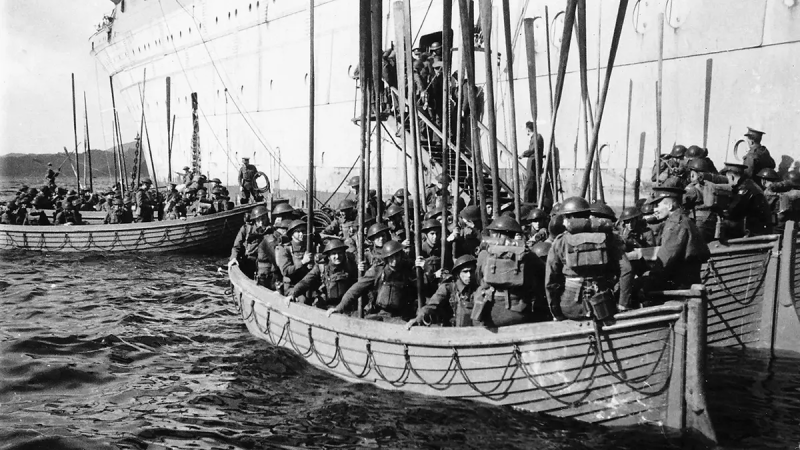
Canadian troops leaving their ship for shore aboard the type of amphibious assault rowboats often used to attack a beachhead before the Higgins Boat. (Mirrorpix via Getty Images)
This age-old art of war, however, "became discredited in World War I and for years thereafter was neglected by all naval powers except Japan," Morison wrote.
Faith in air power, and the famously deadly British military blunder at Gallipoli in 1915, appeared to make amphibious warfare obsolete.
"Amphibious assault is the most ancient form of naval warfare."
"Land-based aircraft and modern coast defense guns would slaughter any landing force before it reached the beach," Morison wrote of the wisdom of the day.
Amphibious invasions of the past reached the beach on standard shallow water boats, either rowed or motorized, that had barely evolved from the days that the Ancient Greeks attacked across the Mediterranean or that Washington crossed the Delaware in 1776.
MEET THE AMERICAN WHO ROWED WASHINGTON ACROSS THE DELAWARE ON CHRISTMAS: SAILOR-SOLDIER JOHN GLOVER
A World War I Marine Corps recruit ad shows jarheads attacking a land target by jumping out of rowboats no different from one they might have rowed across a lake.
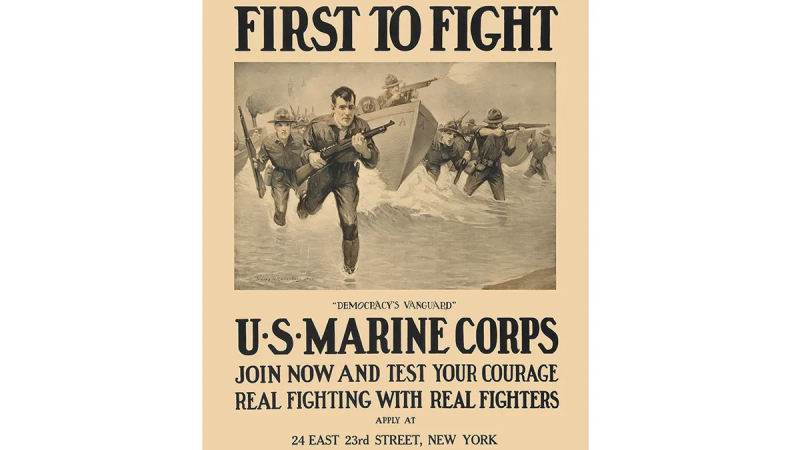
A World War I Marine Corps recruit ad shows jarheads attacking a land target by jumping out of what appear to be rowboats no different from one they might have rowed across a lake. (Buyenlarge/Getty Images)
American military planners of the 1930s bucked the conventional wisdom of the era.
The United States, they correctly assumed, would be forced to insert its forces violently onto hostile beaches across both the Atlantic and the Pacific in the coming two-ocean war.
American military planners turned to Higgins and his Eureka boats.
They needed a new, better and more powerful way to deliver men and equipment from ship to shore.
They turned to Higgins and his Eureka boats. The sturdy but nimble vessels could move in shallow water, they had propellors protected from underwater obstacles and, after powering the bow up on land, they could quickly back up and return to water.
"When tested in 1938 by the Navy and Marine Corps, Higgins' Eureka boat surpassed the performance of [a] Navy-design boat and was tested by the services during fleet landing exercises in February 1939," reports the Naval History and Heritage Command.

Second Lieutenant Walter Sidlowski of 348th Engineer C Battalion, 5th Engineer Special Brigade, on Omaha Beach, Normandy, after helping to rescue a group of drowning soldiers after their landing craft sank on the morning of June 7, 1944, during the Normandy Landings. Colorized photo: PFC Walter Rosenblum (1919-2006). (Walter Rosenblum/U.S. Army Signal Corps/Galerie Bilderwelt/Getty Images)
"Satisfactory in most respects, the boat's major drawback appeared to be that equipment had to be unloaded, and men disembarked over the sides, thus exposing them to enemy fire in a combat situation."
Japan, at the same time, had developed a boat with a drop-down ramp at the bow. Military planners showed a picture to Higgins.
He described it to his chief engineer over the phone and ordered him to work on it immediately.
"Higgins Industries responded by shattering production records, turning out more than 20,000 boats – 12,500 of them LCVPs – by the end of the war."
Higgins Industries successfully demonstrated the new boat with the dropdown bow less than a month later.
The LCVP, the Higgins Boat, was born.
It could carry up to 36 troops with combat gear, a jeep with 12 men, or more than four tons of cargo, deliver all of it right to the beach, back up and return to the mother ship for more men or equipment.
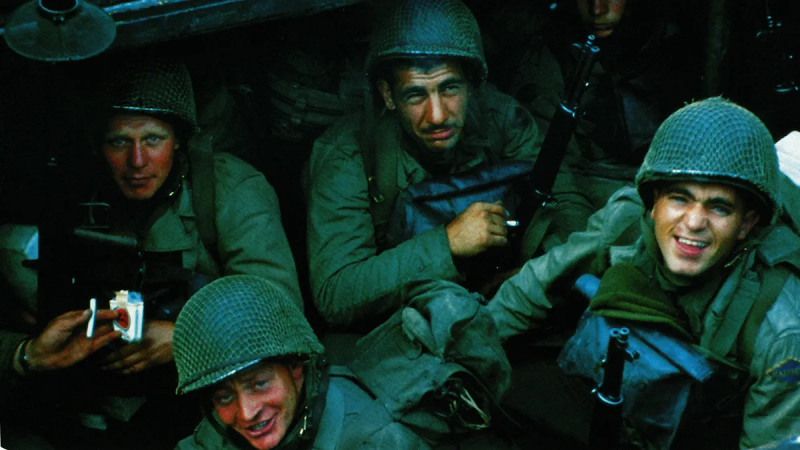
U.S. Rangers from E Company, 5th Ranger Battalion, on board a landing craft assault vessel (LCA) in Weymouth harbour, Dorset, June 4, 1944. The ship is bound for the D-Day landing on Omaha Beach in Normandy. Clockwise, from far left: First Sergeant Sandy Martin, who was killed during the landing, Technician Fifth Grade Joseph Markovich, Corporal John Loshiavo and Private First Class Frank E. Lockwood. They're holding a 60mm mortar, a Bazooka, a Garand rifle and a pack of Lucky Strike cigarettes. (Galerie Bilderwelt/Getty Images)
They were operated by a four-man crew, reached speeds of 12 knots, were armed with two 30-caliber machine guns and could float in just 3 feet of water.
The U.S. and its Allies ordered them by the thousands.
MEET THE AMERICAN WHO FOUGHT AND BLED AT THE ALAMO BUT LIVED TO TELL ITS HEROIC TALE: SLAVE JOE
"In 1938, [Higgins] operated a single boatyard employing less than 75 workers," reports the National World War II Museum of New Orleans.
"By late 1943, seven plants employed more than 25,000 workers. They responded by shattering production records, turning out more than 20,000 boats — 12,500 of them LCVPs — by the end of the war."
Inspired by Missouri shallows
There is a powerful monument today that stands at the head of the pristine rows of white gravestones at Normandy American Cemetery at Omaha Beach.
It depicts a graceful man in bronze, like an ancient god, who appears to be swimming skyward, as if to heaven.
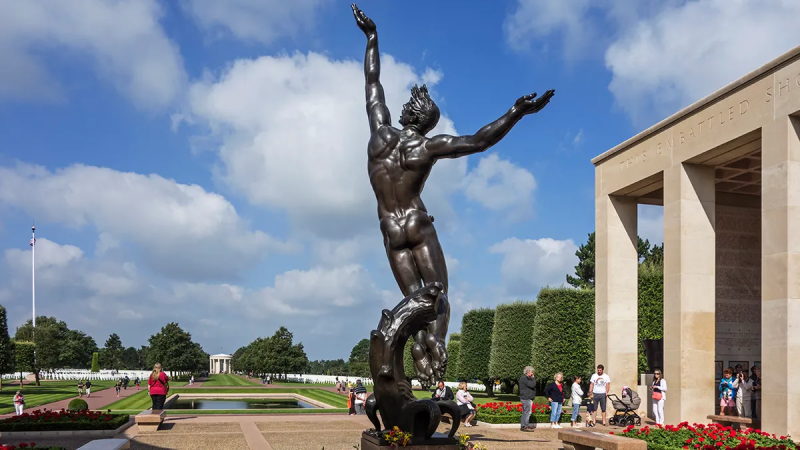
Statue of the "Spirit of American Youth Rising from the Waves," by Donald De Lue at the Normandy American Cemetery and Memorial, Omaha Beach, Colleville-sur-Mer, Normandy, France. (Arterra/Universal Images Group via Getty Images)
It's called the "Spirit of American Youth Rising from the Waves," dedicated to the sacrifices of the 9,386 American soldiers buried in a sprawling ocean-bluff cemetery beyond the monument.
"Ninety-three percent of the U.S. Navy's 14,072 vessels in 1943 were built by Higgins Industries."
"A lot more men would have died if not for the Higgins Boats," said Hoppe, the Nebraska artist, who created two statues dedicated to Higgins.
One stands proudly in their hometown of Columbus, Nebraska. The other stands at Utah Beach in France, where Higgins Boats, and the men on them, led the liberation of Europe.
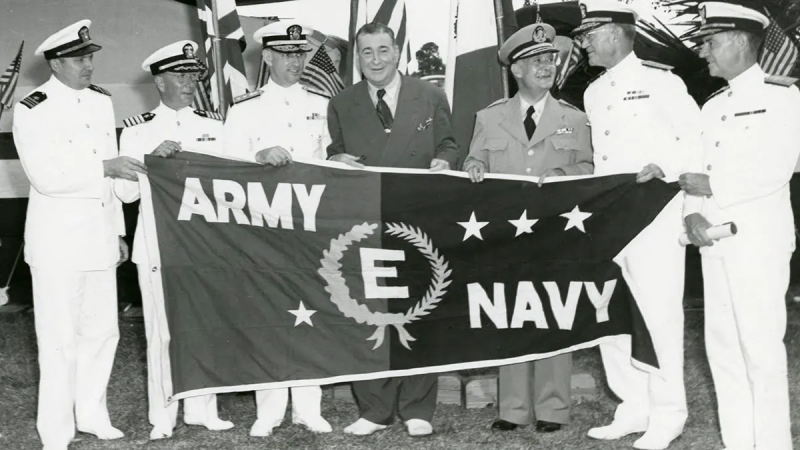
Andrew Higgins, center, in business suit, was the founder of Higgins Industries in New Orleans. His company produced the famous amphibious landing craft, dubbed Higgins Boats, that allowed Allied troops to insert with force into hostile territory around the globe during World War II. (National World War II Museum)
Andrew Jackson Higgins himself died on Aug. 1, 1952, in New Orleans.
He was 65 years old.
"If Higgins had not designed and built those LCVPs, we never could have landed over an open beach," Eisenhower said in 1964, expanding on his claim that Higgins won World War II.
CLICK HERE TO SIGN UP FOR OUR LIFESTYLE NEWSLETTER
"The whole strategy of the war would have been different."
Higgins helped win the war if only by sheer productivity.
"If Higgins had not designed and built those LCVPs, we never could have landed over an open beach"
The U.S. Navy was served by 14,072 vessels at one point in 1943, according to the Andrew Jackson Higgins National Memorial in Nebraska.
An incredible 93% of them, or 12,964, were built by Higgins Industries.
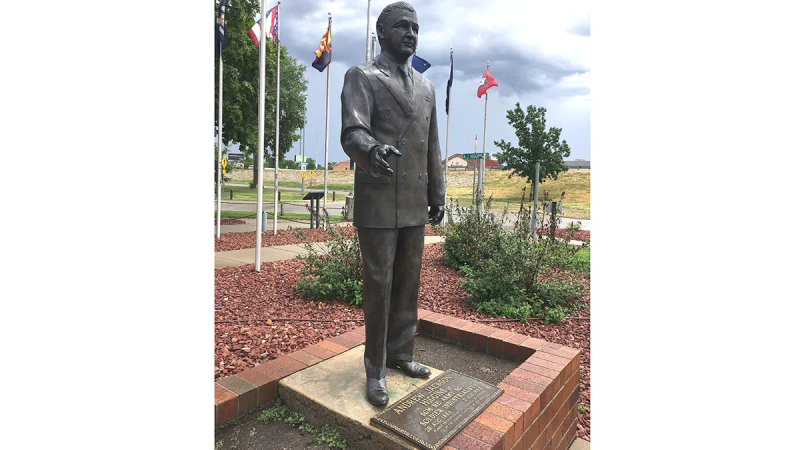
Andrew Higgins memorial in his hometown of Columbus, Nebraska, created by artist and military monument sculptor Fred Hoppe, also from Columbus. A duplicate Higgins sculpture stands over Utah Beach in Normandy, France. (Courtesy Fred Hoppe)
The United States rose to dominance in World War II with its unmatched ability to project force across vast distances.
Among those was the nation's ability to deliver men and equipment to any beach on any ocean in the world.
CLICK HERE TO GET THE FOX NEWS APP
Yet this unprecedented ability to deliver power across the oceans was born in the most heartland of American waterways.

Andrew Higgins, right, designed and built the iconic landing craft of World War II that led the assault on D-Day, among many other battles. An American GI, left — Technician Fifth Grade Joseph Markovich — sits aboard a Higgins Boat on his way to Normandy in 1944. (Getty Images/National World War II Museum)
"If it had not been for the Missouri River at Omaha there would have been no Higgins Industries of New Orleans turning out ships, planes, engines, guns and what have you for the Army and Navy," Higgins reportedly told the Omaha Chamber of Commerce during a speaking engagement in 1943.
To read more stories in this unique "Meet the American Who…" series from Fox News Digital, click here.
"Looking at the Missouri shallows, its snags and driftwood … led [me] to think up [the] first shallow-draft boat. Everything else came from that."
Disclaimer: The copyright of this article belongs to the original author. Reposting this article is solely for the purpose of information dissemination and does not constitute any investment advice. If there is any infringement, please contact us immediately. We will make corrections or deletions as necessary. Thank you.






